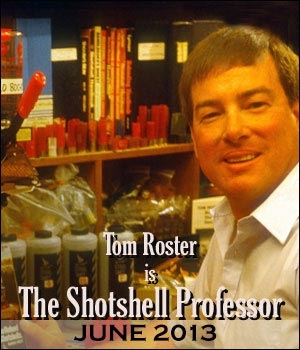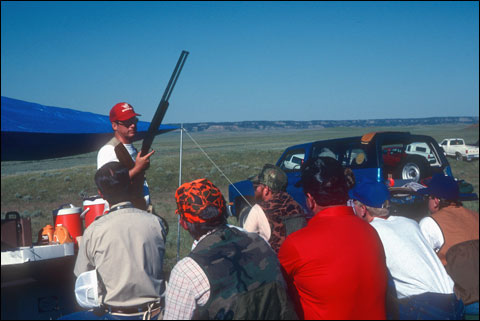Evil Recoil: Part 1

Most shooters recognize sooner or later that recoil is the biggest single negative to their shotgun shooting success. The smart ones recognize this sooner; the recoil-challenged usually later.
There are only three ways to reduce recoil. One is to increase gun weight; the second is to install a spring effect between the gun and the shoulder, i.e., recoil pad, other compressible device, or a gas-operated autoloading action; the third is to reduce the actual recoil created by the shotshell load itself. Of these the most effective is to go right to the shotshell.
I refer every shotgunner to Hodgdon’s Basic Reloaders Manual specifically the section entitled “Shotshell Data” (visit Hodgdon’s website: www.hodgdon.com). Therein you will find an excellent little explanation on the effect of recoil caused by shotshell loads versus gun weight together with as good a formula as any for calculating recoil in shotguns. Let’s use that formula now to look at the amount of recoil shooters are experiencing versus gun weight.
Let’s say you’re a 12-gauge shooter toting a typical sporting clays or waterfowl type shotgun weighing in at close to eight pounds. If you’re shooting a 1⅛-ounce lead load with an instrumental velocity of 1145 feet per second, that load in your eight-pound gun is generating about 19.86 foot/pounds of free recoil; let’s call it 20 ft./lbs. This means during the course of a 100-target competition or practice session you’re going to be absorbing almost exactly one ton of cumulative recoil!
Having kept the scores of hundreds of shooters using nearly eight-pound fixed breech shotguns, their scores over time tell me that 20 ft./lbs. of free recoil is about all any 200-pound person can repeatedly withstand in a 50 to 100 target event without having his scores begin to erode. If you weigh less than 200 pounds, say about 150 pounds, you’re not going to be able handle much more than about 16 ft./lbs. of free recoil throughout a 100-target session. You might get away with more if you go to a gas-operated autoloader, but even then 17 ft./lbs. of free recoil is going to be the absolute max.
Oh, by the way, if you’re a 150-pound shooter but you’re shooting less than an eight-pound gun – gas-operated autoloader or not – you’re not going to be able to handle even 17 ft./lbs. of free recoil. For every pound less in gun weight you are swinging, your shotshell load is going to be transferring significantly more recoil to your body. So, you’re not going to be able to handle very well a 1⅛-ounce load at even 1145 feet per second. You’re going to need to be shooting 7/8 ounce or lighter loads at very modest velocities.
 In his wingshooting clinics Roster stresses the importance of shooting the lightest possible load that will get the job done in order to keep recoil levels manageable. Here he demonstrates with a 20-gauge gun to 12-gauge shooters.
In his wingshooting clinics Roster stresses the importance of shooting the lightest possible load that will get the job done in order to keep recoil levels manageable. Here he demonstrates with a 20-gauge gun to 12-gauge shooters.Let’s look at what happens when we increase the instrumental velocity of a 1⅛-ounce load in that same eight-pound gun by 50 feet per second increments. At 1200 feet per second it delivers to the shooter about 21.5 ft./lbs. of free recoil, at 1250 feet per second about 23 ft./lbs., and at 1300 feet per second almost 25 ft./lbs. of free recoil through the same eight-pound gun.
What to do? Forget about jumping up to ever higher velocity loads. If you need more velocity to help your “leads,” then shoot one ounce or lighter loads in the same eight-pound gun. At 1300 feet per second, a one ounce load would only be transferring about 20.41 ft./lbs. of recoil to your shoulder and face through the same gun. That’s because decreases in shot charge weight have the most significant effect on decreasing recoil. It’s what you have to do if you want to shoot 1300 or so feet per second loads and not have them erode your shooting.
My records show that the best scores over time tend to be shot by shooters dealing with less than 16 ft./lbs. of free recoil. That’s why shooting 7/8-ounce, 20-gauge loads at 1200 fps in even light, little 6½-pound guns is so comfortable: you’re only dealing with about 15.4 ft./lbs. of free recoil from that gun/load combination. Drop down to a ¾-ounce, 1200- feet per second lead load in a 6½-pound gun and you’re only dealing with about 11.5 ft./lbs. of free recoil. And that, my friends, is a recoil level any man, woman or child with a body weight of 125 pounds or more can comfortably shoot 100 rounds a day – every day – and never develop recoil-related flinches or eye-shutting.
In short, recoil is bad; less recoil is always better. The choice is yours.
Tom Roster is an independent ballistics consultant and author specializing in the design and testing of shotshell loads for U.S. shotshell and reloading components manufacturers. He is a court-recognized shotshell/shotgun expert witness. Tom was formerly the Ballistics Research Director at Oregon Institute of Technology and then served as a Ballistics Specialist for the Dept. of the Interior. In these capacities he designed and administered the world’s six most extensive lead versus nontoxic shot duck, goose, pheasant and dove shooting tests ever conducted. He then co-authored their peer-reviewed scientific reports. Roster spends about 100 days afield each year testing lead and nontoxic hunting and target shotshell loads, then traveling worldwide reporting on his findings to industry and wildlife professionals, hunters and shooters, and in his writings for various shotgunning magazines. Contact him in Oregon at (541) 884-2974, tomroster@charter.net.

Tom Roster is an independent ballistics consultant and author specializing in the design and testing of shotshell loads for U.S. shotshell and reloading components manufacturers. He is a court-recognized shotshell/shotgun expert witness. Tom was formerly the Ballistics Research Director at Oregon Institute of Technology and then served as a Ballistics Specialist for the Dept. of the Interior. In these capacities he designed and administered the world’s six most extensive lead versus nontoxic shot duck, goose, pheasant and dove shooting tests ever conducted. He then co-authored their peer-reviewed scientific reports. Roster spends about 100 days afield each year testing lead and nontoxic hunting and target shotshell loads, then traveling worldwide reporting on his findings to industry and wildlife professionals, hunters and shooters, and in his writings for various shotgunning magazines. Contact him in Oregon at (541) 884-2974, tomroster@charter.net.


Comments